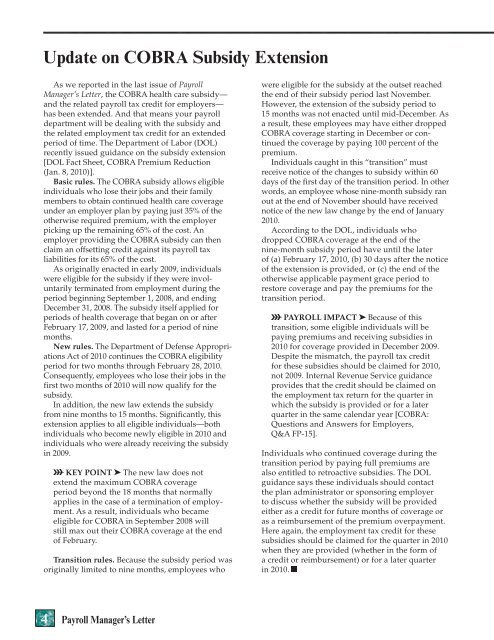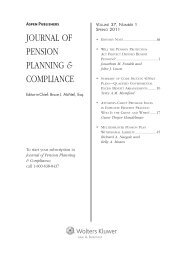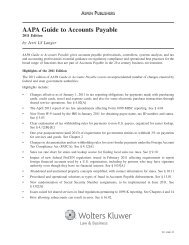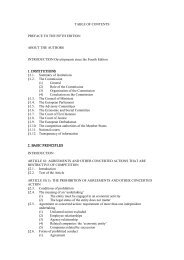Payroll Manager's - Kluwer Law International
Payroll Manager's - Kluwer Law International
Payroll Manager's - Kluwer Law International
You also want an ePaper? Increase the reach of your titles
YUMPU automatically turns print PDFs into web optimized ePapers that Google loves.
Update on COBRA Subsidy Extension<br />
As we reported in the last issue of <strong>Payroll</strong><br />
Manager’s Letter , the COBRA health care subsidy—<br />
and the related payroll tax credit for employers—<br />
has been extended. And that means your payroll<br />
department will be dealing with the subsidy and<br />
the related employment tax credit for an extended<br />
period of time. The Department of Labor (DOL)<br />
recently issued guidance on the subsidy extension<br />
[DOL Fact Sheet, COBRA Premium Reduction<br />
(Jan. 8, 2010)].<br />
Basic rules. The COBRA subsidy allows eligible<br />
individuals who lose their jobs and their family<br />
members to obtain continued health care coverage<br />
under an employer plan by paying just 35% of the<br />
otherwise required premium, with the employer<br />
picking up the remaining 65% of the cost. An<br />
employer providing the COBRA subsidy can then<br />
claim an offsetting credit against its payroll tax<br />
liabilities for its 65% of the cost.<br />
As originally enacted in early 2009, individuals<br />
were eligible for the subsidy if they were involuntarily<br />
terminated from employment during the<br />
period beginning September 1, 2008, and ending<br />
December 31, 2008. The subsidy itself applied for<br />
periods of health coverage that began on or after<br />
February 17, 2009, and lasted for a period of nine<br />
months.<br />
New rules. The Department of Defense Appropriations<br />
Act of 2010 continues the COBRA eligibility<br />
period for two months through February 28, 2010.<br />
Consequently, employees who lose their jobs in the<br />
first two months of 2010 will now qualify for the<br />
subsidy.<br />
In addition, the new law extends the subsidy<br />
from nine months to 15 months. Significantly, this<br />
extension applies to all eligible individuals—both<br />
individuals who become newly eligible in 2010 and<br />
individuals who were already receiving the subsidy<br />
in 2009.<br />
KEY POINT The new law does not<br />
extend the maximum COBRA coverage<br />
period beyond the 18 months that normally<br />
applies in the case of a termination of employment.<br />
As a result, individuals who became<br />
eligible for COBRA in September 2008 will<br />
still max out their COBRA coverage at the end<br />
of February.<br />
Transition rules. Because the subsidy period was<br />
originally limited to nine months, employees who<br />
were eligible for the subsidy at the outset reached<br />
the end of their subsidy period last November.<br />
However, the extension of the subsidy period to<br />
15 months was not enacted until mid-December. As<br />
a result, these employees may have either dropped<br />
COBRA coverage starting in December or continued<br />
the coverage by paying 100 percent of the<br />
premium.<br />
Individuals caught in this “transition” must<br />
receive notice of the changes to subsidy within 60<br />
days of the first day of the transition period. In other<br />
words, an employee whose nine-month subsidy ran<br />
out at the end of November should have received<br />
notice of the new law change by the end of January<br />
2010.<br />
According to the DOL, individuals who<br />
dropped COBRA coverage at the end of the<br />
nine-month subsidy period have until the later<br />
of (a) February 17, 2010, (b) 30 days after the notice<br />
of the extension is provided, or (c) the end of the<br />
otherwise applicable payment grace period to<br />
restore coverage and pay the premiums for the<br />
transition period.<br />
PAYROLL IMPACT Because of this<br />
transition, some eligible individuals will be<br />
paying premiums and receiving subsidies in<br />
2010 for coverage provided in December 2009.<br />
Despite the mismatch, the payroll tax credit<br />
for these subsidies should be claimed for 2010,<br />
not 2009. Internal Revenue Service guidance<br />
provides that the credit should be claimed on<br />
the employment tax return for the quarter in<br />
which the subsidy is provided or for a later<br />
quarter in the same calendar year [COBRA:<br />
Questions and Answers for Employers,<br />
Q&A FP-15].<br />
Individuals who continued coverage during the<br />
transition period by paying full premiums are<br />
also entitled to retroactive subsidies. The DOL<br />
guidance says these individuals should contact<br />
the plan administrator or sponsoring employer<br />
to discuss whether the subsidy will be provided<br />
either as a credit for future months of coverage or<br />
as a reimbursement of the premium overpayment.<br />
Here again, the employment tax credit for these<br />
subsidies should be claimed for the quarter in 2010<br />
when they are provided (whether in the form of<br />
a credit or reimbursement) or for a later quarter<br />
in 2010.<br />
4 <strong>Payroll</strong> Manager’s Letter






